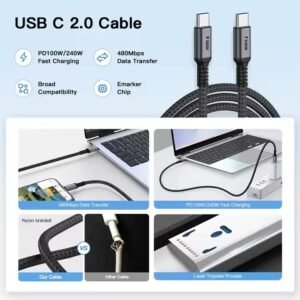High-Quality USB data cable
In the digital age, USB data cable have become an indispensable tool in our daily lives. Whether it is charging a mobile phone, transferring files or connecting peripherals, a high-quality data cable can significantly improve the user experience. This article will provide you with a professional guide to choosing high-quality data cables from multiple dimensions such as material, price, and usage scenarios.
Data cable material analysis: key factors determining durability
The material of the USB data cable directly affects its service life and performance. High-quality materials can effectively resist daily wear and tear and extend the service life of the data cable.
1. Comparison of outer sheath materials
PVC(polyvinyl chloride);the most common cheap,with average flexibility,easy to yellow and harden,and prone to cracks after long-term use, The advantage is that it is cheap and suitable for short-term use or consumers with limited budgets.
TPE (thermoplastic elastomer): a common material for mid-range USB data cable, with good flexibility and elasticity, better bending resistance than PVC, and more environmentally friendly. It feels comfortable and is not easy to tangle, making it a cost-effective choice.
Braided nylon: the preferred material for high-end data cables, woven from hundreds of fine nylon threads, with extremely strong tensile strength and wear resistance. Tests show that the service life of braided nylon data cables can reach 3-5 times that of ordinary PVC cables. In addition, the braided layer can effectively prevent the wire from entanglement.
Kevlar fiber: a military-grade material with extremely high strength and heat resistance (can withstand temperatures of about 500°C), and a tensile strength that is five times that of steel wire. Accordingly USB Data cable reinforced with Kevlar are almost impossible to break, and are suitable for use in extreme environments, but they are expensive.
2. Internal conductor material
Oxygen-free copper (OFC): excellent conductivity, low resistance, and can achieve efficient power transmission and fast data synchronization. High-quality data cables usually use oxygen-free copper with a purity of 4N (99.99%) or above.
Tinned copper: tin is plated on the surface of the copper wire to prevent oxidation, extend the service life, and is suitable for humid environments. However, the conductivity is slightly inferior to pure copper.
Copper clad aluminum: a low-cost solution, with an aluminum core and a copper layer on the outside, poor conductivity, the charging speed may be reduced by 30%-40%, and it is easily damaged by resistance heating.
Silver conductor: top configuration, best conductivity but expensive, mostly seen in professional audio data transmission cables.
3. Interface material and process
Zinc alloy interface: high strength, plug-in resistance, common in mid-to-high-end data cables. High-quality products will be gold-plated to prevent oxidation and ensure good contact.
Plastic interface: low-cost solution, easy to break, metal contacts may deform after long-term use, resulting in poor contact.
Laser welding process: better than ordinary welding, more solid connection, lower resistance. The process level can be judged by observing whether the interface is flat and smooth.
Price range and cost-effectiveness analysis
Data cable prices range from a few yuan to hundreds of yuan. Understanding the characteristics of each price range will help you make a wise choice.
1. Low-price range
Features: mostly PVC outer sheath + copper-clad aluminum conductor, plastic interface, basic functions are acceptable but short lifespan
Applicable scenarios: emergency use or occasions with low quality requirements
Risk warning: There may be safety hazards, obvious heat generation during charging, and unstable data transmission speed
2. Mid-range range
Features: TPE or basic braided outer sheath, oxygen-free copper conductor, zinc alloy interface
Advantages: The most cost-effective, can meet the needs of most users, and the lifespan can reach 1-2 years
Representative brands: Basic models of professional accessory brands such as Anker, Baseus, and UGREEN
3. High-end range
Features: Advanced braided or Kevlar material, gold-plated interface, may include chip certification
Special functions: Support high-power fast charging (such as 100W PD protocol), fast data transmission speed (USB3.2 or above)
Applicable people: professional users, expensive equipment or extremely high stability requirements
4. Luxury range
Features: obvious brand premium, may use special materials such as pure silver conductor, leather wrapping, etc.
Purchase advice: unless you pursue a specific brand or appearance design, the cost performance is not high
Cost performance purchase advice: For most users, it is most cost-effective to choose a professional brand data cable. Its service life and performance far exceed those of cheap products, and the average daily cost is lower.

